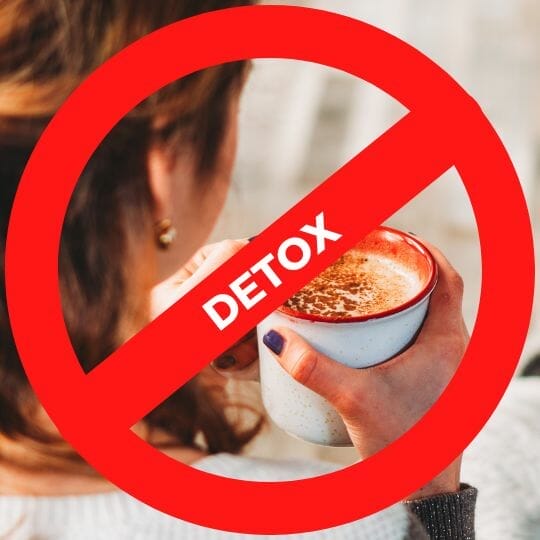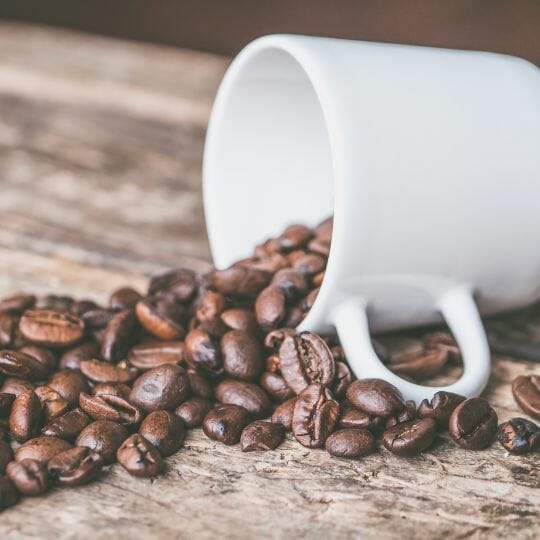
Are you struggling with energy rollercoasters, anxiety or poor sleep? A coffee detox might be part of the solution. It may be a helpful way to give your nervous system a break and feel calmer. Going cold turkey on caffeine can be hard, so this episode outlines how to do a coffee detox so that you can go through the process with ease.
In my investigation of nervous system health and calming down, I’ve decided to do a coffee detox.
This isn’t one of those fad things – I’ve had a few important realisations and am doing it as an experiment to see if it can help me to unwind anxiety, feel calmer, and improve my sleep quality.
Part of this is working out whether I’m consuming too much caffeine for my body weight, and whether removing coffee altogether has a bigger impact on my symptoms.
So today let’s look at recommended caffeine intakes, who may be susceptible to the negative impacts of caffeine, and then, how I’m doing a coffee detox.
Recommended Caffeine Intakes Food Standards ANZ states there is no acceptable daily intake of caffeine but mentions evidence of increased anxiety levels with caffeine consumption at about 3 mg/kg body weight per day.
This equates to:
These are based on standard body weights, so you’d need to work out your recommended intake based on your own body weight.
For example, I weigh 52kg, so, at 3 mg/kg, I can have 52 x 3 = 156 mg caffeine per day.
The challenge is partly that caffeine can come from different sources and in different amounts, so it may be hard to keep track of what you’ve consumed.
To make it a bit easier for consumers, the Food Standards Code restricts caffeine in soft drinks and energy drinks and requires labelling of all sources of caffeine, including guarana, tea, coffee etc.
Soft drinks must not exceed 145 mg/kg of caffeine in the drink, whereas energy drinks must not contain more than 320 mg/L of caffeine. This is the amount in the volume of drink – you then must
convert that to what’s reasonable for your body weight. The label should state the amount of caffeine per serve.
Foods that contain caffeine include chocolate, cola drinks, sports supplements, energy drinks, kola nuts, cocoa beans, coffee beans, tea leaves (and all kinds of tea including green tea), and many weight loss supplements.
Typical amounts of caffeine in different foods are:

So if my caffeine intake is recommended to be 156 mg per day, I can get that amount from either:
You get the idea – it’s about quantity.
Everyone responds differently to caffeine.
Some people get the jitters after one weak coffee, and some can drink 8 coffees a day and still have a solid night’s sleep. Why is that?
Well, your weight sets the scene for your recommended intake as I’ve just described.
On top of that, you might either process and get rid of caffeine quickly or more slowly than other people. On average, it takes between 3 – 12 hours to metabolise and excrete caffeine.
What you eat can affect caffeine metabolism and clearance. For example, large quantities of vitamin C and eating brassica vegetables can speed up your caffeine clearance, whereas alcohol or grapefruit consumption can decrease caffeine clearance.
Depending on your genes, you may be a fast clearer or a slow clearer, and some genotypes are less sensitive to the effects of caffeine.
I had a genetic test years ago that indicated I was a fast metaboliser, but I know that I am sensitive to caffeine because it gives me a noticeable lift and I start talking, thinking and doing fast – sometimes too fast.
More recently, my HealthType test shows I am a Sensor type, and coffee is generally recommended to be avoided, or consumed about once per month.
Coffee or caffeine can certainly help you feel pepped up, but caffeine is addictive and withdrawal can have side effects including depression, low energy, shakiness, anxiety, headache, irritability, fatigue, trouble concentrating and/or constipation.
I recently discovered that going from one espresso to none triggered a terrible headache, brain fog, trouble concentrating and irritability
And having gone through burnout, having been regularly experiencing anxiety and insomnia, and more recently going into menopause, I suspect my adrenal glands have been working overtime and my nervous system has been heavily taxed.

This probably explains my night sweats and some of the other symptoms I’ve mentioned.
I decided I didn’t want coffee controlling me, and it might be worth experimenting with detox to see how I feel when I don’t regularly drink coffee or consume caffeine, especially during menopause.
Here’s my protocol for giving up coffee temporarily to see how it affects me. I will update you once I’ve done a few weeks without coffee on what has changed!
There are lots of ways to do this, but I will be starting slowly and tapering gradually down to zero so I minimise any withdrawal symptoms mentioned above.
Also, I will be making sure I reduce caffeine from other food sources at the same time. When I tried quitting coffee last time, I found myself wanting more chocolate – obviously, my body was looking for sugar and caffeine as a source of energy.
Step 1
Taper from 2 – 3 coffees per day down to one espresso daily for at least one week.
At the same time, I’m making sure I’m getting 2L of water into my diet to ensure good that my digestion and elimination is not affected.
I’ve done this step already at the time of writing.
Step 2
I have previously started mixing regular coffee with decaf in my espresso and that has worked, but this time I will swap to black and green tea and taper that way.
So my step 2 will be to have two black teas per day, and I’ll do that for up to a week depending on my symptoms (or maybe longer). I’ll start this tomorrow.
Step 3
Next, I’ll reduce to one black tea per day.
Step 4
Finally, I’ll go down to rooibos tea only.
I will stay caffeine-free for 3 or 4 weeks to see what changes for me, knowing that after my body has adapted, it will take up to 3 months to be caffeine-free before I see the full physiological effects of reducing caffeine.
Today we talked about the recommended caffeine intake and how caffeine may affect different people differently, especially in terms of anxiety, insomnia and other symptoms.
We covered why some people might want to reduce caffeine, and how to taper gradually and take time away from coffee and caffeine.
You can develop your own protocol for this, I’ve given mine as an example, and hopefully, this helps you to experiment and discover how coffee and caffeine affect you, and whether it’s something you want to continue using.
Understanding who you are and what you need will allow your business to thrive! If you’re truly ready to break old habits and get out of the rut I encourage you to check out the Habitology membership.
Learn more here:
© 2024 Melanie White